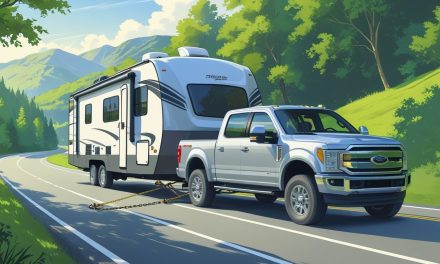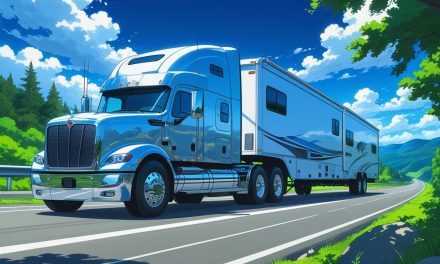Would you like to save this article?
If you’ve ever stood in the garage holding a jug of RV antifreeze and wondered if it could work in your car, you’re not alone. It looks similar, it’s easy to find, and it costs less than automotive coolant.
But the truth is simple: you should not use RV antifreeze in your car’s engine.
RV antifreeze is made for plumbing systems, not engines. It’s designed to keep water lines in campers from freezing, not to handle the high heat and pressure inside a vehicle’s cooling system.
Using it in your car can lead to corrosion, overheating, and costly repairs that far outweigh any short-term convenience. Knowing the difference between these products helps you avoid mistakes that damage your vehicle.
By understanding what each type of antifreeze is made for, you’ll know exactly what belongs in your car and what doesn’t.
Key Takeaways
- RV antifreeze is for plumbing systems, not car engines
- Using the wrong antifreeze can cause damage and overheating
- Always choose the coolant type made for your vehicle
Can I Use RV Antifreeze in My Car?
RV antifreeze and car antifreeze may sound similar, but they serve very different purposes. One is made for plumbing systems in recreational vehicles, while the other is designed to protect your car engine and cooling system under high heat and pressure.
Intended Uses of RV Antifreeze
RV antifreeze is made to protect the fresh water systems in recreational vehicles from freezing during storage. It is usually propylene glycol or alcohol-based, which makes it non-toxic and safe for drinking water lines.
Car antifreeze, often called motor antifreeze or coolant, is very different. It is usually made with ethylene glycol or propylene glycol mixed with additives that prevent corrosion, raise the boiling point, and protect engine parts.
RV antifreeze is not built to handle the high operating temperatures of a car engine. It works well in plumbing systems that never reach extreme heat, but it cannot provide the same thermal protection or stability that your car’s cooling system requires.
Because of these differences, RV antifreeze is not interchangeable with car antifreeze. Using it in your car would not protect the engine from overheating or corrosion.
Manufacturer Recommendations
Car makers design engines with specific cooling systems that require certain antifreeze formulas. Your owner’s manual lists the correct type, such as ethylene glycol-based coolant or a specific extended-life product.
Manufacturers test and approve only those antifreeze types that meet their standards. This ensures proper heat transfer, freeze protection, and corrosion control.
RV antifreeze bottles also state their intended use clearly. They are labeled for plumbing or recreational vehicles, not for motor vehicles.
This distinction is important because it shows the product is not engineered for automotive cooling systems. If you follow the manufacturer’s guidance, you avoid risks to your engine and keep your warranty valid.
Ignoring these instructions by using RV antifreeze could cause problems that are not covered under warranty.
Potential Consequences
Putting RV antifreeze in your car can cause several issues. The product cannot handle the high heat of an engine, so it may boil away or break down quickly.
This leaves your cooling system without proper protection. Without the right antifreeze, your engine can overheat.
Overheating may warp cylinder heads, damage gaskets, or even crack the engine block. RV antifreeze also lacks the corrosion inhibitors found in motor antifreeze.
This can lead to rust, scale buildup, and leaks in your radiator, water pump, or heater core. In some cases, mixing RV antifreeze with car antifreeze can create sludge.
This clogs coolant passages and reduces circulation, which further increases the risk of overheating and costly repairs.
Key Differences Between RV Antifreeze and Automotive Antifreeze
RV antifreeze and automotive antifreeze serve very different purposes. The main differences come from their chemical makeup, temperature performance, and the additives that protect specific systems.
Chemical Composition and Ingredients
RV antifreeze is usually made with propylene glycol or ethanol. These ingredients are chosen because they are non-toxic and safe to use in plumbing systems that carry drinking water.
This is why RV antifreeze is often called the “pink stuff.” Automotive antifreeze, on the other hand, is most often based on ethylene glycol.
Ethylene glycol is highly effective at handling heat transfer in engines but is toxic if swallowed. Some automotive coolants also use propylene glycol, but they are still blended with additives that are not safe for potable water.
The difference in ingredients shows why you should never swap them. RV antifreeze is designed to keep pipes from freezing, not to manage the extreme heat and pressure inside an engine.
Automotive antifreeze is engineered specifically for cooling systems and cannot be safely used in plumbing.
Freezing and Boiling Points
RV antifreeze is designed to protect water lines from freezing in cold weather. Most types protect down to about -50°F (-45°C), but this rating refers to burst protection in pipes, not actual freeze prevention of liquid.
It does not raise the boiling point because plumbing systems never face high heat. Automotive antifreeze works differently.
A 50/50 mix of ethylene glycol and water lowers the freezing point to about -34°F (-37°C) and raises the boiling point to around 223°F (106°C) under normal pressure.
When under system pressure, the boiling point goes even higher, which is critical for hot engines. This ability to handle both freezing and boiling extremes is what makes automotive coolant essential for engines.
RV antifreeze cannot withstand these temperatures and would quickly fail if used in a car’s cooling system.
Additives and Corrosion Protection
RV antifreeze contains little to no corrosion inhibitors because plastic pipes and fittings in plumbing systems don’t need the same protection as metal engine parts. Its focus is on being non-toxic and safe for temporary use in water lines.
Automotive antifreeze includes a complex package of additives that prevent rust, scale, and electrolysis inside the cooling system. These often include organic acid technology (OAT), hybrid organic acid technology (HOAT), or silicate-based inhibitors.
Each type is designed to protect metals like aluminum, iron, and copper found in radiators and engine blocks. Without these additives, your engine would corrode, overheat, and fail prematurely.
RV antifreeze lacks this protection, which is another reason it should never replace automotive coolant. The additives in car antifreeze are what keep your cooling system reliable over thousands of miles.
How RV Antifreeze Works in RV Plumbing
RV antifreeze is designed to protect the plumbing system in recreational vehicles by keeping water lines from freezing, preventing cracks, and ensuring safe use around people and pets. It works differently than automotive antifreeze because it focuses on plumbing safety, not engine cooling.
Freeze Protection for Water Systems
When water freezes inside pipes, it expands and can split fittings or burst lines. RV antifreeze prevents this by lowering the freezing point of water in your plumbing system.
Most RV antifreeze solutions are propylene glycol or ethanol-based. Propylene glycol is common because it provides reliable freeze protection while being safer than automotive antifreeze.
You add RV antifreeze into the plumbing lines after draining water tanks. Once circulated, it replaces any leftover water and creates a barrier against freezing.
This process is essential if you store your RV in climates where temperatures drop below 32°F (0°C). Without it, even small amounts of trapped water can expand and damage your plumbing system.
Non-Toxic Formulations
Unlike automotive antifreeze, which often contains ethylene glycol and is poisonous, RV antifreeze uses non-toxic ingredients so it can safely run through your drinking water lines.
Propylene glycol is the most common option because it is considered food-grade safe in small amounts. Some RV antifreeze products use ethanol, but these can leave an odor or taste in your water system.
Because RV antifreeze is designed for plumbing, you can flush it out in the spring without worrying about harmful residues. This makes it safe for sinks, showers, and toilets that connect to your fresh water supply.
The pink color you often see in RV antifreeze helps you easily identify when the product has fully filled your system.
RV Plumbing Materials Compatibility
RV plumbing systems use materials like PEX tubing, PVC, and rubber seals. RV antifreeze is formulated to be compatible with these materials, reducing the risk of corrosion or breakdown.
Propylene glycol-based antifreeze also acts as a mild lubricant. This helps keep seals, gaskets, and valves from drying out during storage.
Using automotive antifreeze in these systems would damage plastics and rubber, and it would leave behind toxic residues. RV antifreeze avoids these issues by being tailored to the plumbing components found in recreational vehicles.
By using the correct antifreeze, you help extend the life of your RV’s water system and avoid costly repairs.
Risks of Using RV Antifreeze in Car Cooling Systems
RV antifreeze is made for plumbing systems, not engines. It lacks the additives and thermal stability that car antifreeze provides, which can lead to corrosion of metal parts, poor heat transfer, and buildup inside the cooling system.
These issues can shorten engine life and cause expensive repairs.
Corrosion and Material Damage
Your car’s cooling system relies on corrosion inhibitors in automotive antifreeze to protect metal parts such as the radiator, water pump, and cylinder head. RV antifreeze does not include these additives because plumbing systems do not face the same stress.
Without corrosion protection, rust can form on iron and steel components, while aluminum parts may suffer pitting and oxidation. This weakens the cooling system and reduces its ability to regulate temperature.
Rubber seals and plastic parts can also degrade faster when exposed to RV antifreeze. This can lead to leaks and reduced pressure in the cooling system, both of which affect performance.
Reduced Heat Transfer and Overheating
Automotive antifreeze is engineered with additives that improve heat transfer and stabilize coolant under high temperatures. RV antifreeze, usually made with propylene glycol or ethanol, does not handle heat as effectively.
When used in your car, this reduced thermal stability means the coolant cannot carry heat away from the engine efficiently. Over time, this raises the risk of overheating, especially under heavy loads or hot weather conditions.
A car’s cooling system depends on a fluid that can withstand both high pressure and high heat. RV antifreeze is not formulated for these demands, so it may boil sooner or fail to protect against hot spots inside the engine.
This lack of temperature control can damage critical parts such as gaskets, cylinder heads, and the radiator.
Potential for Clogging and Deposit Formation
RV antifreeze is designed to sit in plumbing lines, not circulate under pressure. In a car cooling system, it can leave behind deposits that block narrow coolant passages.
These deposits may form because RV antifreeze lacks detergents and stabilizers found in car antifreeze. As a result, scaling and sludge can build up inside the radiator, heater core, or water pump.
Clogging reduces coolant flow, which further lowers heat transfer efficiency. This creates a cycle of poor cooling and overheating that can quickly damage the engine.
Even partial blockages can cause uneven cooling, leading to hot spots and localized stress on engine components.
Safe Alternatives and Best Practices
You need to use coolant that matches your vehicle’s requirements, follow correct mixing ratios, and act quickly if the wrong product is added. Doing so helps prevent corrosion, overheating, and costly engine damage.
Choosing the Right Coolant
Automotive antifreeze is not one-size-fits-all. Manufacturers design specific coolant formulas to match the metals, seals, and temperature ranges of different engines.
You should always check your owner’s manual or the label on the coolant container to confirm compatibility. Most modern vehicles use ethylene glycol-based coolant with corrosion inhibitors tailored for aluminum and other engine metals.
Some vehicles may call for propylene glycol blends, but these are still engineered for engines, not plumbing systems like RV antifreeze. Coolant types are often color-coded, but color alone is unreliable.
Instead, look for OEM specifications such as HOAT (Hybrid Organic Acid Technology) or OAT (Organic Acid Technology). Using the correct type ensures proper protection against rust, scale buildup, and overheating.
If you are unsure, purchase coolant labeled as “multi-vehicle” that lists your make and model. This reduces the risk of chemical incompatibility and supports long-term engine health.
Proper Use of Automotive Antifreeze
Even the right coolant only works if you use it correctly. Most vehicles require a 50/50 mix of antifreeze and distilled water, which balances freeze protection, boiling resistance, and corrosion control.
Pre-mixed options are available if you want to avoid measuring. Never mix different coolant types unless the product specifically states it is compatible.
Mixing can cause additive dropout, sludge, or reduced corrosion protection. Check coolant levels regularly in both the radiator (when the engine is cool) and the overflow reservoir.
Low levels may signal leaks in hoses, the radiator, or the water pump. Replace coolant at the intervals recommended by your manufacturer, usually every 2–5 years.
Over time, the protective additives break down, leaving your engine vulnerable to rust and overheating.
What to Do if RV Antifreeze Was Used by Mistake
If RV antifreeze enters your cooling system, act quickly. Do not run the engine for long periods, as the fluid cannot handle the heat or protect against corrosion.
Drain the system completely, including the radiator and engine block. Then flush with distilled water until no traces of RV antifreeze remain.
Multiple flushes may be necessary. After flushing, refill with the correct automotive antifreeze mixture.
Bleed air from the system to ensure proper circulation. If the engine was operated with RV antifreeze for more than a short time, have a mechanic inspect for signs of corrosion, clogging, or overheating damage.
Prompt action reduces the risk of long-term engine harm.
Understanding Antifreeze Types and Technologies
Different antifreeze types use specific chemical blends that affect how well they protect against freezing, overheating, and corrosion. The formula you choose matters because it determines compatibility with your vehicle’s cooling system and how long the protection lasts.
Organic Acid Technology (OAT)
OAT antifreeze relies on organic acids instead of silicates or phosphates to prevent corrosion. You often see it in modern vehicles because it offers long service life, sometimes up to 5 years or 150,000 miles.
This type usually comes in colors like orange, red, or dark green, though color alone is not a reliable guide. What makes OAT different is that it avoids fast-depleting additives, so it protects aluminum and other metals for longer periods.
You should not mix OAT with older antifreeze types. Mixing can shorten its lifespan and reduce protection against scale and rust.
If your car requires OAT, always match the specification listed in your owner’s manual.
Hybrid Organic Acid Technology (HOAT)
HOAT antifreeze combines organic acids with small amounts of silicates. This blend gives you the long-lasting protection of OAT while adding faster-acting corrosion defense for aluminum and iron.
It is common in many European and some American vehicles. HOAT is often yellow, turquoise, or pink, but again, color is not a guarantee of type.
You will find HOAT works well in cooling systems that use aluminum radiators and water pumps. It usually lasts about 5 years, though some extended-life versions claim longer.
Always stick to the vehicle maker’s recommendation, since using the wrong type can lead to deposits or leaks.
Marine Antifreeze and Other Variants
Marine antifreeze, like RV antifreeze, is usually propylene glycol-based. It is designed for plumbing and water systems, not engines.
Its main role is to prevent freezing in pipes and tanks without releasing toxic chemicals into drinking water systems.
Unlike automotive antifreeze, marine antifreeze does not provide the same high-temperature stability or corrosion inhibitors required for engines.
Other variants include inorganic antifreeze with silicates and phosphates, often used in older vehicles.
Each type has a specific purpose, so you should only use the formula made for your engine’s design.





